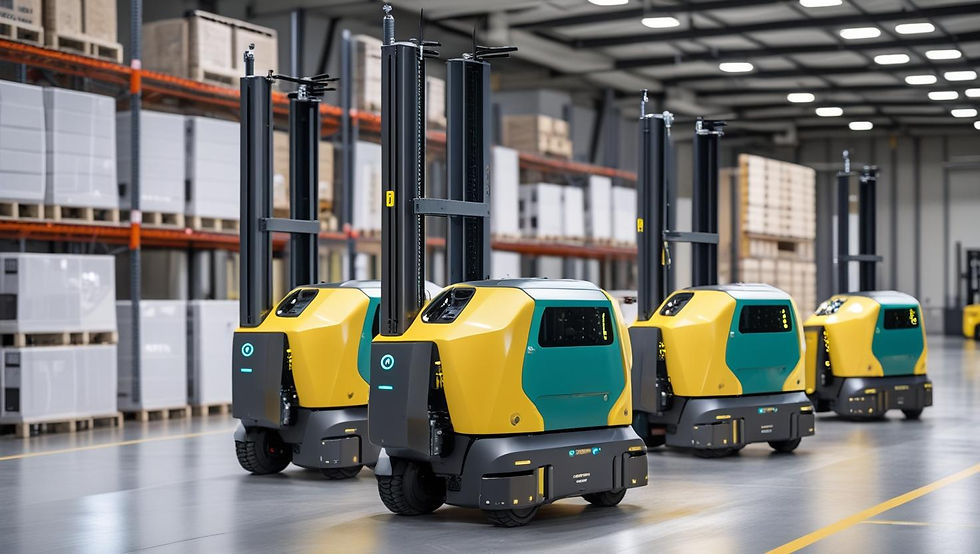The Evolution of Material-Handling Safety: From Reactive to Proactive
- Seeteria Team

- Dec 30, 2024
- 3 min read
Updated: Jul 3
The Reactive Era, The Regulatory Shift, The Data Decade, The Proactive AI Edge.
Safety has always been a critical concern in material handling. As the backbone of industries like warehousing, manufacturing, and logistics, material handling safety involves high-stakes operations with heavy equipment like forklifts, cranes, and conveyor belts. Over the decades, safety standards in this field have undergone a significant transformation—moving from reactive measures to proactive safety standards and predictive solutions.

The Early Days: Learning from Incidents
In the early 20th century, material handling safety was largely reactive. Regulations were minimal, and practices were often dictated by trial and error. Accidents and injuries were seen as unavoidable risks of the job. However, as industrialization ramped up and the number of workplace injuries grew, the need for formal safety protocols became evident.
Key Milestone: The creation of the Occupational Safety and Health Administration (OSHA) in 1971 marked a turning point in material-handling safety. For the first time, the U.S. had a federal agency that could set and enforce detailed rules rather than rely on voluntary guidelines. One flagship example is OSHA’s powered industrial truck standard (29 CFR 1910.178), which spells out operator-training hours, daily inspection checklists, load-capacity limits, and design requirements for every forklift sold or operated in the country. By defining clear responsibilities for employers, employees, and equipment makers, OSHA shifted safety from optional best practice to mandatory workplace culture
The Rise of Technology: Enhancing Safety
The late 20th century brought technological advancements that revolutionized material handling safety. Innovations like seat belts on forklifts, ergonomic equipment design, and automated conveyor systems began to address key safety challenges.
Training Programs: Operator certification and structured training became mandatory in many regions, ensuring workers understood the equipment and protocols.
Regulatory Standards: Organizations such as ANSI and ISO introduced guidelines to standardize safety practices across industries.
The Digital Revolution: Proactive Safety Measures
The 21st-century digital age gave rise to proactive safety standards, where sensors, telematics, data analytics, and vision AI work together to spot hazards early and neutralize them before they escalate.
Examples Include:
Collision Detection Systems: Early warning systems on forklifts to prevent crashes.
Wearable Tech: Devices monitoring workers’ fatigue and alertness.
IoT and Connectivity: Real-time data sharing between equipment and management for better decision-making.
The AI Era: Predictive Safety
Today, we stand on the brink of a new era in material handling safety: one driven by artificial intelligence and vision AI. These technologies are transforming the way industries approach risk management.

AI-Powered Predictions: AI can analyze patterns to forecast potential accidents before they happen.
Vision AI: Cameras equipped with AI detect hazards in real time, alerting operators and management to take preventive actions.
Automated Insights: Advanced analytics provide tailored safety recommendations, empowering organizations to create safer workplaces.
What’s Next?
The future of material handling safety lies in deeper integration of technology, regulation, and human-centric design. As AI continues to evolve, we can expect even more precise, efficient, and proactive safety standards. Furthermore, the global focus on sustainability will likely influence the development of greener, safer equipment and processes.
Conclusion
The evolution of safety standards in material handling reflects a broader societal shift: from accepting accidents as inevitable to actively preventing them. At Seeteria, we’re proud to contribute to this journey by offering cutting-edge AI-driven solutions that not only protect workers but also enhance operational efficiency. Together, we can build a future where safety is not just a priority but a given.
Let’s move forward - safely.
Interested in learning how Seeteria can enhance safety in your facility? Contact us today to explore tailored solutions.




Comments